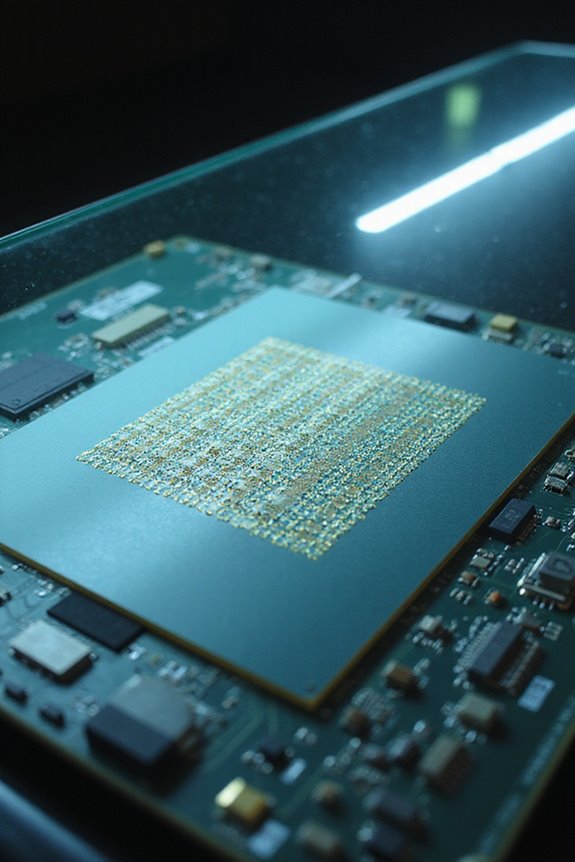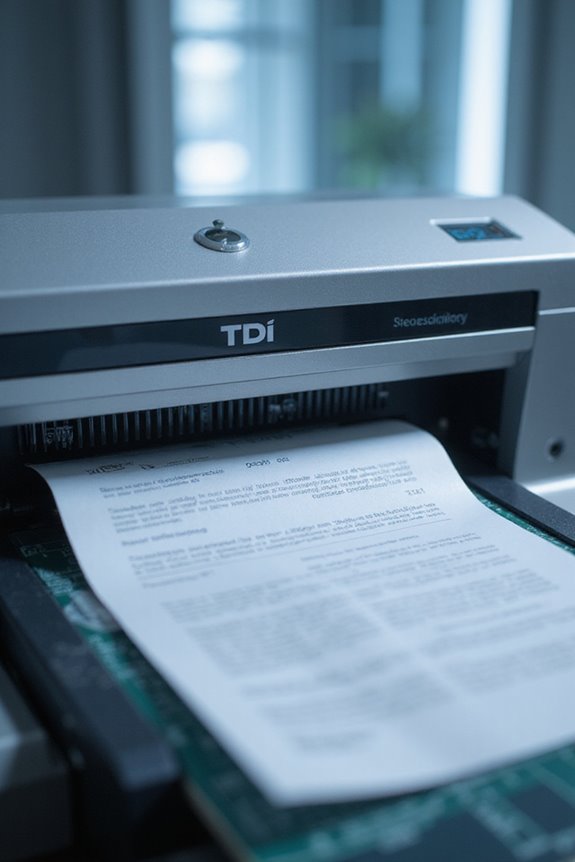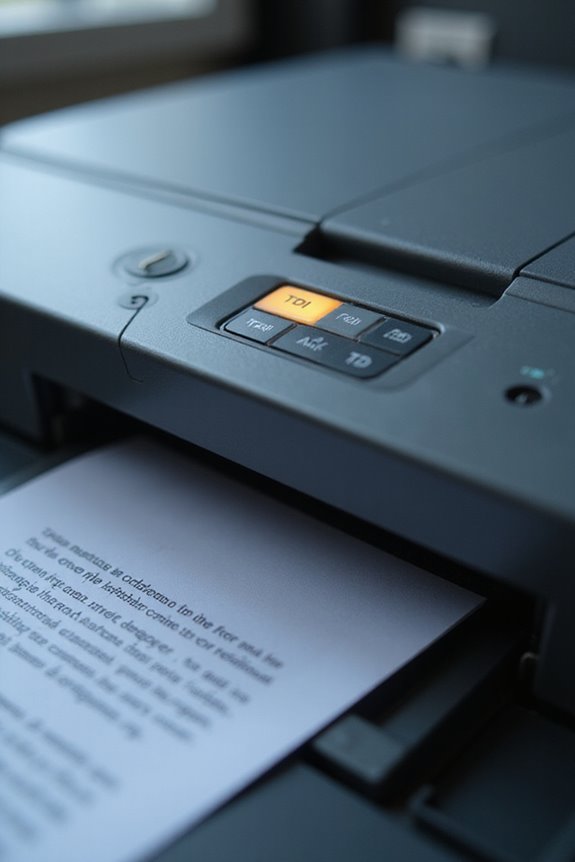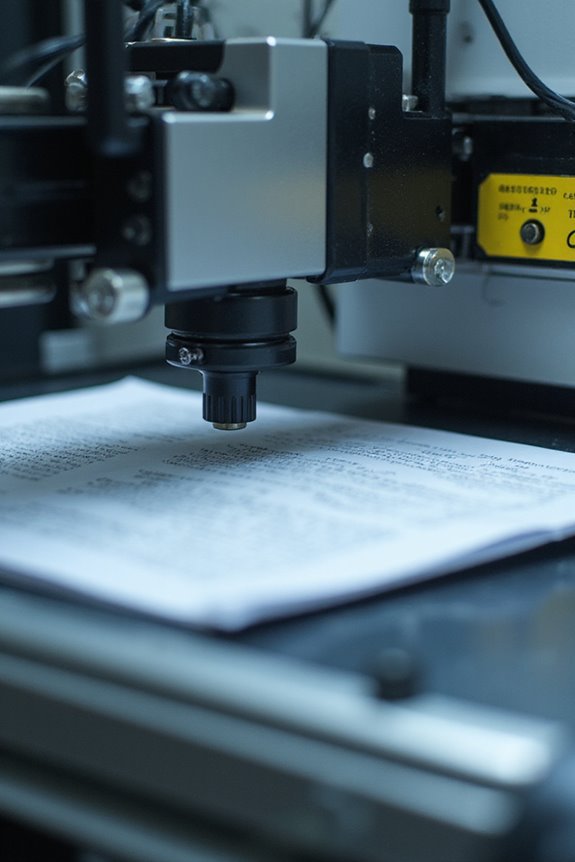To effectively use scanner Time Delay Integration (TDI), we need to select the right TDI sensor and calibrate its settings carefully. This enhances our low-light imaging and reduces motion blur. We should synchronize the scanner with the object’s speed to optimize charge transfer. Additionally, enabling gain mechanisms can greatly improve our results. Regular calibration under different lighting conditions helps maintain quality. By following these steps, we can achieve exceptional image clarity and performance. More details follow.
Key Takeaways
- Choose an appropriate TDI sensor or camera model based on your specific imaging requirements and application.
- Calibrate sensor parameters effectively, ensuring optimal settings for TDI mode and low-light performance.
- Synchronize the scanner with the speed of the moving object to ensure precise charge transfer and minimize motion blur.
- Implement gain mechanisms to enhance signal sensitivity in low-light conditions during TDI operation.
- Regularly perform calibration tests and adjust for environmental factors to maintain image quality and sensor timing.
Understanding Time Delay Integration (TDI)
When we consider Time Delay Integration (TDI), we find it’s a powerful technique designed to improve imaging of fast-moving objects in low light. TDI applications span industries, including robotics, astronomy, and surveillance, offering enhanced clarity by synchronizing charge transfer with object motion. This method reduces motion blur considerably, ensuring high-resolution images even in challenging conditions. However, TDI does have limitations; it requires precise motion tracking and may struggle with fast, erratic movements. Additionally, setup complexity can increase cost and training needs. Despite these challenges, TDI revolutionizes imaging by integrating multiple exposures, effectively boosting sensitivity. Ultimately, it allows us to capture stunningly clear images, making it an essential tool in modern imaging technology. The importance of choosing the right scanner for specific projects can further enhance the effectiveness of TDI applications.
Technical Implementation of TDI in Scanners

Implementing Time Delay Integration (TDI) in scanners is a crucial step toward capturing high-quality images of fast-moving objects. Our TDI sensor designs utilize multiple linear arrays, allowing TDI charge transfer to occur in sync with the object’s motion. By precisely coordinating charge transfer, we accumulate signal packets over successive exposures, greatly reducing motion blur.
Additionally, the number of TDI stages affects sensitivity; more lines equal higher signal integration, which is essential for low-light conditions. To enhance performance, we can integrate advanced TDI sensors, like EMCCD-based models, for increased sensitivity and lower noise. Proper hardware architecture supports rapid charge transfer, ensuring consistent results, while optimized configurations minimize illumination requirements, helping reduce costs. This thoughtful implementation ultimately enhances image clarity and accuracy. Moreover, duplex scanning technology allows for capturing both sides of documents efficiently, making it ideal for various applications.
Advantages of Using TDI Technology

Understanding the benefits of Time Delay Integration (TDI) technology can greatly elevate our imaging capabilities. TDI provides excellent sensitivity, greatly improving our signal-to-noise ratio. This enhancement allows us to capture high-quality images even in low-light conditions, a key advantage for TDI applications in delicate inspections. Furthermore, TDI enables increased scanning speed without image degradation, boosting throughput in production environments while reducing cycle times. We can perform rapid inspections efficiently, like in semiconductor manufacturing. Additionally, TDI’s ability to lower lighting requirements cuts operational costs and helps protect sensitive samples, minimizing heat exposure. Overall, the TDI benefits greatly enhance image quality, detecting even the smallest defects effectively, making it essential for high-resolution imaging tasks. Scanners with high-resolution scanning capabilities, such as the Epson Expression 13000XL, can further optimize TDI’s advantages in detailed imaging applications.
Steps to Effectively Use TDI Mode

To effectively use TDI mode, we must carefully consider several key steps in both setup and operation. First, we need to select the appropriate TDI sensor or CCD camera based on our TDI applications. During TDI calibration, configuring the sensor parameters like the number of TDI stages is essential for achieving desired integration times. Next, we should guarantee our mechanical or electronic scanning system is synchronized with the object’s speed. Adjusting the scan speed helps maintain charge transfer accuracy. Along with that, enabling gain mechanisms can greatly enhance performance in low light. Additionally, understanding the importance of compatibility with existing devices can further optimize the scanning process. Finally, initiating the scan sequence and utilizing software to aggregate integrated charges will lead to high-quality image formation, ensuring we’re making the most of TDI technology.
Essential Considerations for Synchronization

Success in TDI mode depends heavily on how well we synchronize pixel integration with the scene’s movement. Achieving pixel coherence is essential; we need the pixel integration time to align perfectly with the scene’s travel time. If we’re out of sync, we risk signal loss and motion blur, which steers us away from ideal charge accumulation. Utilizing multi-phase charge transfer can help minimize motion artifacts by allowing multiple shifts within each integration period. When we increase the number of charge transfer phases, we enhance our image sharpness and reduce discrepancies caused by scene movement. This meticulous timing control ultimately leads to superior image quality, maximizing performance and improving sensitivity in challenging lighting conditions. Additionally, implementing OCR technology in conjunction with TDI can further enhance text recognition capabilities in scanned documents.
Challenges When Using TDI in Scanners
While TDI scanning offers impressive advantages, it also presents several challenges that users must navigate. One significant hurdle is managing motion artifacts, which can occur if synchronization fails. These issues degrade image fidelity, making it tough to capture clear images. We also face the complexity of Dark Signal Non-Uniformity (DSNU), where image quality suffers without proper correction, potentially slowing down our scanning speed. Plus, achieving precise motion synchronization can be technically challenging; even small mismatches lead to blur. Additionally, longer exposure times may be required under low light, heightening the risk of motion distortion. Altogether, addressing these challenges is essential for optimizing TDI performance and ensuring high-quality scans. Furthermore, maintaining scanning speed is crucial to prevent delays in high-demand environments.
Best Practices for Maintaining TDI Performance
Maintaining ideal TDI performance involves a series of best practices that align synchronization, calibration, and environmental controls. We should guarantee precise synchronization between integration time and scan rates to minimize motion blur. Using TDI calibration methods like time delay estimation can correct misalignments, enhancing image quality. Additionally, optimizing charge transfer mechanisms with multi-phase clocking improves charge accuracy and reduces contamination risks.
We recommend regular calibration tests under varied lighting to maintain a high signal-to-noise ratio. Environmental controls are essential too; stable temperatures and vibration damping mounts help prevent drift in sensor timing. By following these best practices, we can considerably enhance TDI performance and ultimately achieve sharper, clearer images that meet our high standards.
Frequently Asked Questions
What Types of Sensors Are Compatible With TDI Technology?
When we explore sensor types compatible with TDI technology, we find that CCD, CMOS, and hybrid sensors often dance harmoniously together. However, compatibility issues can occasionally arise, affecting performance in specific applications.
How Does Ambient Light Affect TDI Performance?
We recognize that ambient light greatly impacts TDI performance by affecting sensor sensitivity. Excessive illumination can reduce signal-to-noise ratios, so managing ambient conditions is essential for maintaining high image quality and effective motion compensation.
Can TDI Be Used for Still Images?
Imagine capturing a still life where fruits glisten under soft light. While TDI applications excel for moving objects, its advantages don’t translate for stills, making conventional imaging methods more suitable and effective for static scenes.
What Maintenance Is Required for TDI Scanners?
Maintaining TDI scanners involves regular calibration, software updates, and inspections. We need to clean components, check alignment, and monitor illumination for peak performance, ensuring our scanning remains sharp and efficient throughout its use.
How Does Temperature Impact TDI Imaging Quality?
Let’s say temperature’s a little fickle in TDI imaging. Its effects can sway our imaging stability, increasing noise and affecting brightness. We need to stay mindful of keeping those temperatures in check for ideal results!





